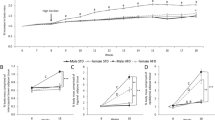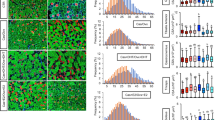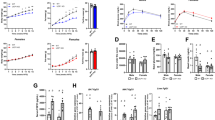Abstract
Members of the uncoupling protein (UCP) family have different purported functions, which can be either directly or indirectly related to the control of body weight. In this sense, most studies on this topic have been carried out using male subjects, although different works with males and females have shown important sex-associated differences in the regulation of these proteins; for instance, sex differences have been shown in the cold-, diet- and overweight-induced expression of brown adipose tissue UCP1 and also in the correlation of muscle UCP3 with overweight. In these kinds of studies, models of obesity such as cafeteria diet feeding and postcafeteria have been very useful. Moreover, sex hormones have been shown to modulate UCP1 expression in brown adipocytes in vitro. All these sex-dependent differences, as well as sex differences in body weight gain under a hypercaloric diet, could be related to the different respective biological functions of males and females, taking into account the fact that the gender effect in future studies on obesity could be of interest.
This is a preview of subscription content, access via your institution
Access options
Subscribe to this journal
Receive 12 print issues and online access
$259.00 per year
only $21.58 per issue
Buy this article
- Purchase on Springer Link
- Instant access to full article PDF
Prices may be subject to local taxes which are calculated during checkout
Similar content being viewed by others
References
Palou A, Picó C, Bonet ML, Oliver P . The uncoupling protein, thermogenin. Int J Biochem Cell Biol 1998; 30: 7–11.
Ricquier D, Bouillaud F . The uncoupling protein homologues: UCP1, UCP2, UCP3, StUCP and AtUCP. Biochem J 2000; 345 (Part 2): 161–179.
Boss O, Samec S, Paoloni-Giacobino A, Rossier C, Dulloo A, Seydoux J, Muzzin P, Giacobino JP . Uncoupling protein-3: a new member of the mitochondrial carrier family with tissue-specific expression. FEBS Lett 1997; 408: 39–42.
Gong DW, He Y, Karas M, Reitman M . Uncoupling protein-3 is a mediator of thermogenesis regulated by thyroid hormone, beta3-adrenergic agonists, and leptin. J Biol Chem 1997; 272: 24129–24132.
Vidal-Puig A, Solanes G, Grujic D, Flier JS, Lowell BB . UCP3: an uncoupling protein homologue expressed preferentially and abundantly in skeletal muscle and brown adipose tissue. Biochem Biophys Res Commun 1997; 235: 79–82.
Clapham JC, Arch JR, Chapman H, Haynes A, Lister C, Moore GB, Piercy V, Carter SA, Lehner I, Smith SA, Beeley LJ, Godden RJ, Herrity N, Skehel M, Changani KK, Hockings PD, Reid DG, Squires SM, Hatcher J, Trail B, Latcham J, Rastan S, Harper AJ, Cadenas S, Buckingham JA, Brand MD . Mice overexpressing human uncoupling protein-3 in skeletal muscle are hyperphagic and lean. Nature 2000; 406: 415–418.
Cadenas S, Echtay KS, Harper JA, Jekabsons MB, Buckingham JA, Grau E, Abuin A, Chapman H, Clapham JC, Brand MD . The basal proton conductance of skeletal muscle mitochondria from transgenic mice overexpressing or lacking uncoupling protein-3. J Biol Chem 2002; 277: 2773–2778.
Nedergaard J, Cannon B . Pros and cons for suggested functions. Exp Physiol 2003; 88: 65–84.
Samec S, Seydoux J, Dulloo AG . Role of UCP homologues in skeletal muscles and brown adipose tissue: mediators of thermogenesis or regulators of lipids as fuel substrate? FASEB J 1998; 12: 715–724.
Argyropoulos G, Brown AM, Willi SM, Zhu J, He Y, Reitman M, Gevao SM, Spruill I, Garvey WT . Effects of mutations in the human uncoupling protein 3 gene on the respiratory quotient and fat oxidation in severe obesity and type 2 diabetes. J Clin Invest 1998; 102: 1345–1351.
Himms-Hagen J, Harper ME . Physiological role of UCP3 may be export of fatty acids from mitochondria when fatty acid oxidation predominates: an hypothesis. Exp Biol Med (Maywood) 2001; 226: 78–84.
Quevedo S, Roca P, Picó C, Palou A . Sex-associated differences in cold-induced UCP1 synthesis in rodent brown adipose tissue. Pflugers Arch 1998; 436: 689–695.
Roca P, Rodríguez AM, Oliver P, Bonet ML, Quevedo S, Picó C, Palou A . Brown adipose tissue response to cafeteria diet-feeding involves induction of the UCP2 gene and is impaired in female rats as compared to males. Pflugers Arch 1999; 438: 628–634.
Rodríguez E, Monjo M, Rodríguez-Cuenca S, Pujol E, Amengual B, Roca P, Palou A . Sexual dimorphism in the adrenergic control of rat brown adipose tissue response to overfeeding. Pflugers Arch 2001; 442: 396–403.
Rodríguez AM, Quevedo-Coli S, Roca P, Palou A . Sex-dependent dietary obesity, induction of UCPs, and leptin expression in rat adipose tissues. Obes Res 2001; 9: 579–588.
Rothwell NJ, Stock MJ . The cafeteria diet as a tool for studies of thermogenesis. J Nutr 1988; 118: 925–928.
Herrmann SM, Wang JG, Staessen JA, Kertmen E, Schmidt-Petersen K, Zidek W, Paul M, Brand E . Uncoupling protein 1 and 3 polymorphisms are associated with waist-to-hip ratio. J Mol Med 2003; 81: 327–332.
Gabaldon AM, Florez-Duquet ML, Hamilton JS, McDonald RB, Horwitz BA . Effects of age and gender on brown fat and skeletal muscle metabolic responses to cold in F344 rats. Am J Physiol 1995; 268: R931–941.
Gabaldon AM, McDonald RB, Horwitz BA . Effects of age, gender, and senescence on beta-adrenergic responses of isolated F344 rat brown adipocytes in vitro. Am J Physiol 1998; 274: E726–736.
Rodriguez AM, Roca P, Bonet ML, Pico C, Oliver P, Palou A . Positive correlation of skeletal muscle UCP3 mRNA levels with overweight in male, but not in female, rats. Am J Physiol Regul Integr Comp Physiol 2003.
Vidal-Puig AJ, Grujic D, Zhang CY, Hagen T, Boss O, Ido Y, Szczepanik A, Wade J, Mootha V, Cortright R, Muoio DM, Lowell BB . Energy metabolism in uncoupling protein 3 gene knockout mice. J Biol Chem 2000; 275: 16258–16266.
Weigle DS, Levin BE . Defective dietary induction of uncoupling protein 3 in skeletal muscle of obesity-prone rats. Obes Res 2000; 8: 385–391.
Kobori M, Yamamuro T . Effects of gonadectomy and estrogen administration on rat skeletal muscle. Clin Orthop 1989. 306–311.
Eason JM, Schwartz GA, Pavlath GK, English AW . Sexually dimorphic expression of myosin heavy chains in the adult mouse masseter. J Appl Physiol 2000; 89: 251–258.
Rodríguez AM, Monjo M, Roca P, Palou A . Opposite actions of testosterone and progesterone on UCP1 mRNA expression in cultured brown adipocytes. Cell Mol Life Sci 2002; 59: 1714–1723.
Acknowledgements
This work was supported by the Spanish Government (Programa de Promoción a la Investigación Biomédica y en Ciencias de la Salud, Ministerio de Sanidad y Consumo, FIS 01/1379) and by the European Commission (COST action 918).
Author information
Authors and Affiliations
Corresponding author
Rights and permissions
About this article
Cite this article
Rodríguez, A., Palou, A. Uncoupling proteins: gender dependence and their relation to body weight control. Int J Obes 28, 500–502 (2004). https://doi.org/10.1038/sj.ijo.0802588
Received:
Revised:
Accepted:
Published:
Issue Date:
DOI: https://doi.org/10.1038/sj.ijo.0802588
Keywords
This article is cited by
-
Diet-induced obesity affects expression of adiponutrin/PNPLA3 and adipose triglyceride lipase, two members of the same family
International Journal of Obesity (2012)
-
Oxidative stress and inflammation interactions in human obesity
Journal of Physiology and Biochemistry (2012)
-
Gender-dependent gene expressions in brown adipose tissue of lean and obese rats fed a high fat diet
Biotechnology and Bioprocess Engineering (2012)
-
DNA microarray analysis reveals differential gene expression in the soleus muscle between male and female rats exposed to a high fat diet
Molecular Biology Reports (2012)
-
Slc27a2 expression in peripheral blood mononuclear cells as a molecular marker for overweight development
International Journal of Obesity (2010)



